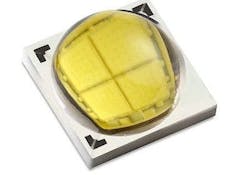Some Lumileds LEDs have an extrapolated L70 lifetime of 114 years
LED maker Lumileds (San Jose, CA), which is the company that first came up with lumen-maintenance testing for LEDs in 2008, today (April 11, 2017) let it be known that it is the only company that has met the premium specifications of the DesignLights Consortium (DLC) in four main product families.
Some of Lumileds' manufacturing and testing processes that the company says it has been improving over the years include: epitaxy, new phosphor development, die fabrication, and in-situ process control, with more than 3 billion device-hours of testing under its belt.
LED lifetimes
Because lighting LEDs tend to wane in output over time rather than burn out like an incandescent bulb, their lifetime specifications take this into account. When an LED is new, it will have an output of a certain number of lumens. This number of lumens gradually decreases; at the time when the LED output has waned to 90% of its original lumens, the LED is said to have reached its L90 lifetime. Similarly, at 70% of its output, the LED has reached its L70 lifetime, and 50% of its output defines its L50 lifetime.
The lighting LED industry has taken the L70 lifetime as its standard. In contrast, the L90 standard is much stricter. Even so, many of Lumileds' LED products demonstrate L90 times in excess of 100,000 hours (the DLC Premium requirements are a mere 36,000 hours).
This is great, but what happens if we relax the L90 criterion to the L70 industry standard and apply it to Lumileds' LEDs? Well, Lumileds says that a range of its LEDs exceeds an extrapolated L70 lifetime of 1,000,000 hours.
114 years
But why is this an extrapolated rather than a measured figure? The simple answer is that 1,000,000 hours is about 114 continuous years of operation—or far longer than the LED industry has existed. So Lumileds has to characterize the much smaller decrease in output of its longest-life LEDs and extrapolate that data to find the L70 lifetime figure.
For more info, see lumileds.com.
Source: Lumileds
About the Author
John Wallace
Senior Technical Editor (1998-2022)
John Wallace was with Laser Focus World for nearly 25 years, retiring in late June 2022. He obtained a bachelor's degree in mechanical engineering and physics at Rutgers University and a master's in optical engineering at the University of Rochester. Before becoming an editor, John worked as an engineer at RCA, Exxon, Eastman Kodak, and GCA Corporation.

